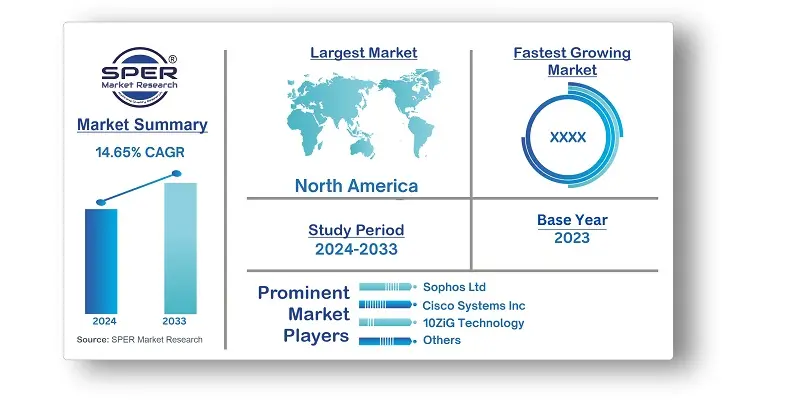
United States Virtualization Security Market Trends, Share, Size, Revenue and Future Outlook
United States Virtualization Security Market Growth, Size, Trends Analysis– By Virtualization Type, By Component, By Type of Virtual Infrastructure, By End User- Regional Outlook, Competitive Strategies and Segment Forecast to 2033
| Published: Oct-2024 | Report ID: IACT24177 | Pages: 1 - 102 | Formats*: |
| Category : Information & Communications Technology | |||
- May 2020; The third annual Modern Bank Heists report, created by VMware Carbon Black, was made public by VMware Inc. According to the research, there was a twofold rise in assaults directed at the country's BFSI sector and a five-fold increase in ransomware attacks inside the financial industry between February and April 2020.
- November 2019; With the creation of a cloud platform prepared for financial services in partnership with Bank of America, IBM concentrated on attracting clients in the financial services industry. To service its more than 60 million banking clients, Bank of America is anticipated to use the platform and host essential apps.


| Report Metric | Details |
| Market size available for years | 2020-2033 |
| Base year considered | 2023 |
| Forecast period | 2024-2033 |
| Segments covered | By Virtualization Type, By Component, By Type of Virtual Infrastructure, By End User |
| Regions covered | Northeast, Midwest, South, West |
| Companies Covered | VMware Inc, Trend Micro Incorporated, Sophos Ltd, Hytrust Inc, Juniper Networks Inc, 10ZiG Technology, Cisco Systems Inc, Centrify Corporation, McAfee LLC, Fortinet Inc. |
- IT and Security Professionals
- Cloud Service Providers
- Data Centre Operators
- Managed Service Providers
- Government Agencies
- Virtualization Software Vendors
- System Integrators
- Network Administrators
- Compliance and Risk Management Officers
- Cybersecurity Consultants
| By Virtualization Type: | |
| By Component: | |
| By Type of Virtual Infrastructure: | |
| By End User: |
- United States Virtualization Security Market Size (FY’2024-FY’2033)
- Overview of United States Virtualization Security Market
- Segmentation of United States Virtualization Security Market By Virtualization Type (Hardware Virtualization, Software Virtualization)
- Segmentation of United States Virtualization Security Market By Component (Solutions, Services)
- Segmentation of United States Virtualization Security Market By Type of Virtual Infrastructure (Hypervisor, Virtual Machines, Web Servers, Other Virtual Infrastructures)
- Segmentation of United States Virtualization Security Market By End User (IT and Telecom, Cloud Service Providers, Data Centres, BFSI, Healthcare, Government, Other End-Users)
- Statistical Snap of United States Virtualization Security Market
- Expansion Analysis of United States Virtualization Security Market
- Problems and Obstacles in United States Virtualization Security Market
- Competitive Landscape in the United States Virtualization Security Market
- Impact of COVID-19 and Demonetization on United States Virtualization Security Market
- Details on Current Investment in United States Virtualization Security Market
- Competitive Analysis of United States Virtualization Security Market
- Prominent Players in the United States Virtualization Security Market
- SWOT Analysis of United States Virtualization Security Market
- United States Virtualization Security Market Future Outlook and Projections (FY’2024-FY’2033)
- Recommendations from Analyst
1.1. Scope of the report1.2. Market segment analysis
2.1. Research data source
2.1.1. Secondary Data2.1.2. Primary Data2.1.3. SPER’s internal database2.1.4. Premium insight from KOL’s
2.2. Market size estimation
2.2.1. Top-down and Bottom-up approach
2.3. Data triangulation
4.1. Driver, Restraint, Opportunity and Challenges analysis
4.1.1. Drivers4.1.2. Restraints4.1.3. Opportunities4.1.4. Challenges
4.2. COVID-19 Impacts of the United States Virtualization Security Market
5.1. SWOT Analysis
5.1.1. Strengths5.1.2. Weaknesses5.1.3. Opportunities5.1.4. Threats
5.2. PESTEL Analysis
5.2.1. Political Landscape5.2.2. Economic Landscape5.2.3. Social Landscape5.2.4. Technological Landscape5.2.5. Environmental Landscape
5.2.6. Legal Landscape
5.3. PORTER’s Five Forces
5.3.1. Bargaining power of suppliers5.3.2. Bargaining power of buyers5.3.3. Threat of Substitute5.3.4. Threat of new entrant5.3.5. Competitive rivalry
5.4. Heat Map Analysis
6.1. United States Virtualization Security Market Manufacturing Base Distribution, Sales Area, Product Type6.2. Mergers & Acquisitions, Partnerships, Product Launch, and Collaboration in United States Virtualization Security Market
7.1. United States Virtualization Security Market Size, Share and Forecast, By Virtualization Type, 2020-20267.2. United States Virtualization Security Market Size, Share and Forecast, By Virtualization Type, 2027-20337.3. Hardware Virtualization7.4. Software Virtualization
8.1. United States Virtualization Security Market Size, Share and Forecast, By Component, 2020-20268.2. United States Virtualization Security Market Size, Share and Forecast, By Component, 2027-20338.3. Solutions8.4. Services
9.1. United States Virtualization Security Market Size, Share and Forecast, By Type of Virtual Infrastructure, 2020-20269.2. United States Virtualization Security Market Size, Share and Forecast, By Type of Virtual Infrastructure, 2027-20339.3. Hypervisor9.4. Virtual Machines9.5. Web Servers9.6. Other Virtual Infrastructures
10.1. United States Virtualization Security Market Size, Share and Forecast, By End User, 2020-202610.2. United States Virtualization Security Market Size, Share and Forecast, By End User, 2027-203310.3. IT and Telecom10.4. Cloud Service Providers10.5. Data Centers10.6. BFSI10.7. Healthcare10.8. Government10.9. Other End-Users
11.1. United States Virtualization Security Market Size and Market Share By Region (2020-2026)11.2. United States Virtualization Security Market Size and Market Share By Region (2027-2033)11.3. United States
11.3.1. Northeast11.3.2. Midwest11.3.3. South11.3.4. West
12.1. VMware Inc
12.1.1. Company details12.1.2. Financial outlook12.1.3. Product summary12.1.4. Recent developments
12.2. Trend Micro Incorporated
12.2.1. Company details12.2.2. Financial outlook12.2.3. Product summary12.2.4. Recent developments
12.3. Sophos Ltd
12.3.1. Company details12.3.2. Financial outlook12.3.3. Product summary12.3.4. Recent developments
12.4. Juniper Networks Inc
12.4.1. Company details12.4.2. Financial outlook12.4.3. Product summary12.4.4. Recent developments
12.5. 10ZiG Technology
12.5.1. Company details12.5.2. Financial outlook12.5.3. Product summary12.5.4. Recent developments
12.6. Cisco Systems Inc
12.6.1. Company details12.6.2. Financial outlook12.6.3. Product summary12.6.4. Recent developments
12.7. Centrify Corporation
12.7.1. Company details12.7.2. Financial outlook12.7.3. Product summary12.7.4. Recent developments
12.8. McAfee LLC
12.8.1. Company details12.8.2. Financial outlook12.8.3. Product summary12.8.4. Recent developments
12.9. Fortinet Inc.
12.9.1. Company details12.9.2. Financial outlook12.9.3. Product summary12.9.4. Recent developments
12.10. Hytrust Inc
12.10.1. Company details12.10.2. Financial outlook12.10.3. Product summary12.10.4. Recent developments
SPER Market Research’s methodology uses great emphasis on primary research to ensure that the market intelligence insights are up to date, reliable and accurate. Primary interviews are done with players involved in each phase of a supply chain to analyze the market forecasting. The secondary research method is used to help you fully understand how the future markets and the spending patterns look likes.
The report is based on in-depth qualitative and quantitative analysis of the Product Market. The quantitative analysis involves the application of various projection and sampling techniques. The qualitative analysis involves primary interviews, surveys, and vendor briefings. The data gathered as a result of these processes are validated through experts opinion. Our research methodology entails an ideal mixture of primary and secondary initiatives.



Frequently Asked Questions About This Report
PLACE AN ORDER
Year End Discount
Sample Report
Pre-Purchase Inquiry
NEED CUSTOMIZATION?
Request CustomizationCALL OR EMAIL US
100% Secure Payment






Related Reports
Our Global Clients
Our data-driven insights have influenced the strategy of 200+ reputed companies across the globe.




















